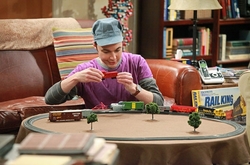Sheldon and his toy train set.
 Sheldon was running his new train set when he notices something. The train is moving with uniform acceleration and the front end of the train passes an electric pole by the track with a velocity
x
and the rear end passes the pole with a velocity
y
. What is the velocity of the middle of the train when it crosses the pole?
Sheldon was running his new train set when he notices something. The train is moving with uniform acceleration and the front end of the train passes an electric pole by the track with a velocity
x
and the rear end passes the pole with a velocity
y
. What is the velocity of the middle of the train when it crosses the pole?
This section requires Javascript.
You are seeing this because something didn't load right. We suggest you, (a) try
refreshing the page, (b) enabling javascript if it is disabled on your browser and,
finally, (c)
loading the
non-javascript version of this page
. We're sorry about the hassle.
5 solutions
Nice way :D
Nicely formatted @Akhilesh Agrawal
Perfectly done.
I'm confused why do the different sections of the train have different velocities?
Using
v
2
=
u
2
+
2
a
s
we get
y
2
=
x
2
+
2
a
L
where
L
is the length of the train. This implies that:
2
a
L
=
y
2
−
x
2
.
Similarly, if the midpoint of the train passes the pole with a velocity of
z
, then:
2
a
(
2
L
)
=
z
2
−
x
2
.
This implies that:
2
(
z
2
−
x
2
)
=
y
2
−
x
2
⇒
2
z
2
−
2
x
2
=
y
2
−
x
2
⇒
2
z
2
=
y
2
+
x
2
⇒
z
=
2
x
2
+
y
2
y^2-x^2=2as hence a=(y^2-x^2)/2s now m^2-x^2=2(y^2-x^2/2s)(s/2) therefore m^2=x^2+(y^2-x^2/2) hence m^2=x^2+y^2/2 hence m=sqrt(x^2+y^2/2)
as we all are aware from the formula v.^2-u>^2=2as; where v=final velocity; u=initial velocity; a=constant acceleration; s=displacement; ...so applying this equation for first case when the train has passed whole pole...; 2ad=y.^2-x.^2; d= Lenght of train; then a=(y.^2-x.^2)/2d; ..... now for the scnd case 2a (d/2)=v.^2-x.^2; where v is velocity to be find; putting the value of "a" here; 2 {(y.^2-x.^2)/2d}*d/2=v.^2-x.^2); then we get the value of v as sqrt((y.^2+x.^2)/2); answer
from the image posted, the train is travelling in a circulary way. this is no doubt possible, since a=ct ! ( and a= w^2 * R ) ! so , in my opinion, the image should be removed !
Let the velocity of the middle part be Z, the acceleration of the train be 'a' and length of train be 'l'. So by third eqn of motion, y^2=x^2 + 2al.... this gives us al=(y^2-x^2)/2 We also get an eqn y^2=Z^2+al (as the length here will be l/2) putting the value of al...we get y^2=Z^2+(y^2-x^2)/2 by solving this we get Z=[(y^2+x^2)/2]^1/2
Using v 2 = u 2 + 2 a s , we get
y 2 = x 2 + 2 a s
Now we need the distance to be half with the acceleration constant and therefore the 2 a s term becomes a s which is
2 y 2 − x 2 , this gives the equation.
Let the velocity when the middle of the train crosses the pole be k m s − 1
k 2 = x 2 + 2 y 2 − x 2
This gives k 2 = 2 y 2 + x 2 ⟹ k = 2 x 2 + y 2